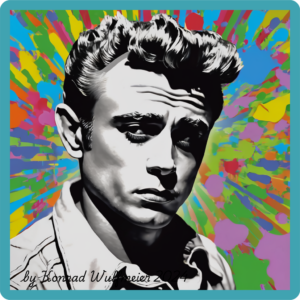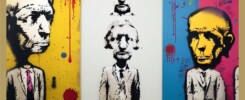Turn On – AI Has No Soul, But the AI Artist Does
Artificial Intelligence (AI) has sparked a revolutionary shift in the art world. Within seconds, an algorithm can generate images, compose music, or even write poetry. And yet, a lingering question hangs in the air: Does AI have a soul? Or, more pointedly: if the machine cannot feel, can its art truly move us?
This article explores the fault line between soulless technology and soulful art. And it poses a central thesis: AI is not the artist – the human

who uses it is. The AI artist. What defines this new kind of creator? How is the relationship between inspiration, expression, and creation transforming in the age of intelligent algorithms? And what role does the soul play – that mysterious, creative center of our inner world?
1. The Illusion of Creation: When Algorithms “Make” Art
We live in a time when AI can generate a painting in seconds – a task that might take a human days, weeks, or months. The results are often stunning, visually rich, and technically brilliant. And yet, for those who look deeper, there’s an odd emptiness. Why?
AI analyzes data, detects patterns, and replicates styles. It simulates creativity without ever truly experiencing it. An AI-generated artwork can be beautiful, but it often lacks the depth that springs from lived experience. AI does not know what loss feels like. It does not feel longing. It can “depict” love, but it does not love. And therein lies the divide.
AI can remix millions of artworks into something “new.” But it has no soul, no intuition, no pain, awe, or devotion. Everything it produces is mathematically traceable – and yet it lacks the one thing great art demands: real human experience.
2. The AI Artist: A Human Between Machine and Muse
Still, fascinating works are emerging in the age of AI – not through machines alone, but through humans who shape them with vision and intuition. The AI artist is not a passive observer of technology but an active creator. They don’t use AI as a replacement, but as a tool – an extension of their imagination.
The AI artist is a mediator between human and machine. They bring soul to the soulless. They don’t just program algorithms – they shape meaning. Their task is not merely technical but profoundly creative. They choose which data to feed, what rules to apply, and which outputs to accept or discard. They respond to the machine’s suggestions with an inner compass – with emotion, aesthetics, and judgment.
In a sense, the AI artist engages in a dialogue with the machine. And like any good dialogue, it’s full of surprises, tension, and resonance. The machine offers impulses – the human gives them meaning. From this tension arises a new form of art: techno-sensual creativity.
3. Soul in Art: What Truly Moves Us
What do we really mean when we speak of “soul” in art? Is it the ineffable something that lingers in a painting? Is it the emotional current that hits us without words? Or is it the intention – the creative spark that travels from maker to viewer?
Art with soul emerges when the artist truly shows up. With their life, their feelings, their contradictions. Even in AI art, this is possible – but only when the human infuses technology with their inner drive. It’s an alchemical process: Binary code becomes soulful form when guided by a soulful awareness.
In my work with QuantumNature-Art, that’s precisely the goal: translating the depth of human experience into digital form. AI is my brush, my instrument. But the melody comes from me – from memories, dreams, intuition.
4. Between Technology and Transcendence: A New Artform
We stand at a turning point in art history. Never before has the bond between technology and inspiration been so intense. AI is not the enemy of human creativity – it’s a mirror, an amplifier, sometimes even a catalyst. But it remains a tool.
The true art lies in crossing thresholds: when humans begin to dance with machines creatively. When they don’t let AI dehumanize them, but instead humanize the machine – through their gaze, their choices, their presence.
QuantumNature-Art seeks to be a bridge between nature, consciousness, and digital transformation. It proves that even digital works can carry soul – when they’re created from a place of inner truth. This is art that’s not only visually striking but meaningful.
5. Emotion and Intuition in the Digital Space
Many assume that AI-created art is “cold” or “artificial.” And yes – it often is. But it doesn’t have to be. When the artist follows their emotional compass, when they choose with heart and intuition what to keep or discard, then AI art gains emotional depth.
The digital realm is not a soulless wasteland. It’s like a dormant landscape waiting to be activated through our inner resonance. The better an artist knows themselves, the more authentic their AI-supported work becomes. It can be sad, ecstatic, tender, political – everything we carry inside can be expressed anew through AI.
6. Responsibility and Awareness: The Ethics of the AI Artist
With great power comes great responsibility. The AI artist is not just a creator, but also a curator and guardian. They choose what is shown – and what isn’t. Which narratives are reinforced by AI – and which biases must be stopped from being replicated.
Because AI is not neutral. It reflects the data it’s fed – including all prejudices, clichés, and systemic flaws. The AI artist must be aware of this. They must develop an ethical consciousness that extends beyond the act of creation.
Art with soul is not blind. It sees, reflects, transforms. It asks why. And it knows it’s part of something larger – a cultural, societal, spiritual matrix.
7. The Future of Art: Between Human, Machine, and Mystery
Where are we heading? Will the AI artist become the new avant-garde? Or will the line between human and machine-made art disappear entirely?
Perhaps the future lies in merging: in consciously blending human soul with machine logic. In art that’s born of inner visions and digital processes alike. In works that touch us emotionally while challenging us intellectually.
QuantumNature-Art is an example of this – a practice that connects new tech with timeless questions of meaning, beauty, and truth. The art of tomorrow won’t be soulless – not if we aren’t. The soul doesn’t come from the machine – it comes from the human who guides it.
8. Conclusion: The Soul Lives in the Artist, Not the Code
AI has no soul – but that doesn’t mean AI art must be soulless. What matters is who creates it, why, and how. The AI artist is not a technician, but a seeker. Not just a user, but a bridge between worlds.
If we understand art as the expression of our deepest inner movements, then one thing becomes clear: Even in the age of AI, the soul of art remains the most vital force. And it’s up to us to fuel that force with courage, depth, and awareness.
Turn on – not despite AI, but through it. If we use it wisely and sensitively, AI can become part of our artistic journey. And perhaps, it can even help us better understand ourselves – as humans, as artists, as soulful beings.
© 2025 Konrad Wulfmeier | Master Code™ – QuantumNature-Art

